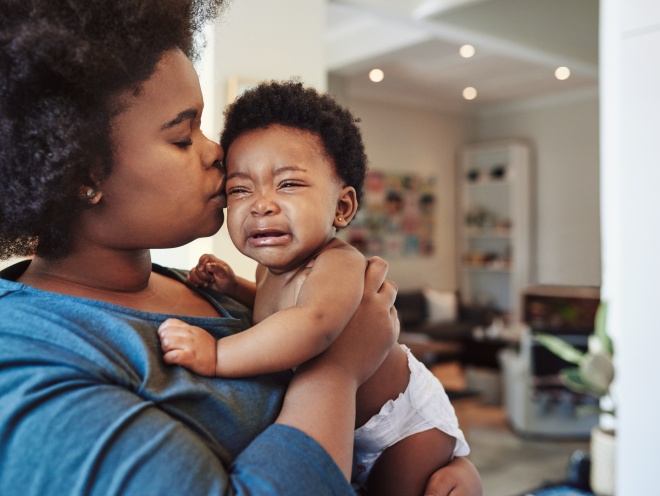One of the first things you’ll notice as a parent is that babies cry. Here we look at what makes babies cry and how to help them settle.
Experiencing your baby crying can be upsetting, frustrating and exhausting. Not only are you trying to work out what’s wrong, but you’re desperately trying to soothe them at the same time. Don’t despair, all parents have been there and it’s a natural part of the journey.
When will my baby stop crying so much?
The good news is it doesn’t last forever. Babies cry most in the first three months of their lives (Wolke et al, 2017).
It’s normal for babies to sometimes cry inconsolably. Studies have shown that two in ten infants cry for long periods without an apparent reason during the first four months (Wake et al, 2006). On average they’ll cry for two to three hours a day (Wolke et al, 2017).
This can’t be normal, or can it?
Even if your baby is crying a lot, it might be that your baby is going through what is sometimes called the period of PURPLE crying – a perfectly normal stage of development. (PURPLE is not about the colour – it’s short for: Peak of crying; Unexpected; Resists soothing; Pain-like face; Long lasting; and Evening.)
PURPLE crying is a stage of inconsolable crying that can last up to five hours a day (NCSBS, no date). The idea is that a lot of people misunderstand developmental crying, labelling it as colic and mistakenly thinking their baby is unwell.
Why is my baby crying?
Babies communicate with cues signalling their needs but it can take a while for you to learn their language. While you’re learning, your baby may resort to their last means of getting your attention – crying.
As you observe and get to know your baby, you’ll be able to anticipate and respond to their needs before they start to cry. And even when they are crying, you’ll have a good idea what the problem might be, or will recognise their different cries (Sandru et al, 2017). There are some very common reasons for crying, and ways you can help.
I’m hungry
It might not seem long since they’ve last fed but your baby’s tummy is tiny and can’t hold much milk. Plus they have a lot of growing and brain development to do. If you’re breastfeeding, you could offer them the breast until they come off naturally. If you’re bottle feeding, then try paced feeding.
If your baby continually cries while breastfeeding, you might want to check their attachment. You could also get support from your midwife, health visitor or the NCT Support Line to see if there is a reason for the tears.
Reading the food cues
Crying is a late sign of hunger, and it is easier to feed your baby before they start to cry. Certain behaviour tells you when they’re ready to feed, such as:
- rooting for the breast
- licking lips
- fist in mouth
- getting agitated.
Acting quickly stops hungry becoming hangry (anger due to hunger) (NHS, 2019).
I’m tired
Babies often cry when they’re tired, and it’s easy for them to become overtired if there's a lot going on. You may find it helps your baby drift off to sleep if you hold, stroke or shush them. You could also try driving or walking them around; or finding a quiet, dark room where you can both have a nap.
I’m wet and dirty
It can’t be nice for a baby to sit in their own poo, and a dirty nappy can irritate a baby’s sensitive skin. You might find trying some nappy-free time helpful to avoid nappy rash but just remember to put a protective towel underneath.
Being prepared for each nappy change can help you get quick at changing your baby. It can also avoid any tears caused by cold air making your baby feel exposed during nappy changes.
I need a cuddle
After nine months of living inside a parent, it’s a big deal to suddenly be on your own.
Babies need a lot of love and reassurance. Giving your baby lots of cuddles and interaction, such as talking and playing, helps them to feel comforted and secure. And a secure baby is better able to grow and thrive.
I’m in pain or unwell
If it’s not immediately obvious why your baby is crying, it could be pain or illness like teething, wind, earache or a headache from a more complicated birth. No one knows your baby as well as you do so if you’re worried, get medical help.
In an emergency, you can get NHS advice by calling 111. If you fear you baby is in immediate danger, call 999.
I’m colicky or in the PURPLE crying period
There is a big possibility it’s PURPLE crying as that can last up to five hours a day. (PURPLE is not about the colour – it’s short for: Peak of crying; Unexpected; Resists soothing; Pain-like face; Long lasting; and Evening.) This is commonly known as colic.
You can try lots of different methods to sooth a baby with PURPLE crying, such as:
- distractions
- shushing
- white noise
- going for a walk or drive
- carrying them in a sling.
(NHS Hull University Teaching Hospital, no date).
Remember that you can call the NCT Infant Feeding Support Line on 0300 330 0700, or seek help from a healthcare professional.
I’m too hot or too cold
Make sure your baby’s clothing is right for the weather. When it’s hot and sunny, offer them plenty to drink and don’t spend more than a few minutes in direct sunlight. When it’s cold, keep them wrapped up but regularly check they’re not excessively hot if wearing several layers of thick clothes.
I’ve got wind
When everything’s so small, there’s not much room for food to be digested. For some babies, wind can be a source of discomfort worth crying about. You could try the following to help your baby’s food go down and the burps come up:
- Winding your baby – rubbing and patting them on the back.
- Gently massaging their stomach in a clockwise direction.
- Slowly bending their legs towards their stomach, like they’re riding a bike.
I need attention
When babies are really young and still learning about the world and their place in it, they might cry just to check that someone is still there protecting them. Over time, older babies may learn that crying leads to attention and crying may become more about wants than needs.
It’s up to each parent how they manage cries that relate to wanting attention. You might use approaches from cuddling or feeding, through to tips on soothing. Whichever method you choose, be prepared for changes in your baby’s routine, even from one day or night to the next.
My adult is stressed
Babies pick up on our emotions as parents, so if you’re feeling stressed, they can feel unsettled. Taking a short, five-minute break to calm yourself can help both you and your baby. Put them down somewhere safe, and phone a friend, make a cuppa, or take some breaths outside.
When you return, they may have calmed down or fallen asleep. If not, then at least you’ve had a break and can start to care for them again.
Will it ever end?
Rest assured: every parent has felt overwhelmed by their baby’s crying at some point. It’s OK to take time out for a few minutes. Make sure your baby is safe in their cot or pram and give yourself a break. If possible, get your partner, a family member or friend to take over.
By six months, babies cry less as they grow and you learn to recognise their communication. It won’t happen overnight, and there will be plenty of tears to come but as with every stage of a baby’s life, this phase won’t last forever.
This page was last reviewed in April 2022.
Further information
Our support line offers practical and emotional support with feeding your baby and general enquiries for parents, members and volunteers: 0333 252 5051.
You might find attending one of our NCT New Baby groups helpful as they give you the opportunity to explore different approaches to important parenting issues with a qualified group leader and other new parents in your area.
Make friends with other parents-to-be and new parents in your local area for support and friendship by seeing what NCT activities are happening nearby.
Watch our coping with crying film.
Understanding Childhood also have a range of resources available online and to download, developed by child psychotherapists, including a leaflet on crying.
There’s also useful information on the NHS website.
The NSPCC helpline provides help and support to thousands of parents and families.
The Lullaby Trust has lots of useful information and support for parents about safe sleep.
NCSBS. (no date) What is the period of PURPLE crying? Available at: http://www.purplecrying.info/what-is-the-period-of-purple-crying.php [Accessed 8th April 2022]
NHS. (2019) Breastfeeding: the first few days. Available at: https://www.nhs.uk/conditions/baby/breastfeeding-and-bottle-feeding/bre…
NHS Hull University Teaching Hospital. (no date) Prolonged (PURPLE) crying in babies: information for parents and carers. Available at: https://www.hey.nhs.uk/patient-leaflet/prolonged-purple-crying-in-babie… [Accessed 19th March 2022]
Sandru ED, Buzo A, Cucu H, Burileanu C. (2017) Recent Experiments and findings in baby cry classification. In: International Conference on Future Access Enablers of Ubiquitous and Intelligent Infrastructures (pp. 253-260). Springer, Cham. Available at: https://link.springer.com/book/10.1007/978-3-319-92213-3?page=3#toc [Accessed 8th April 2022]
Wake M, Morton-Allen E, Poulakis Z, Hiscock H, Gallagher S, Oberklaid F. (2006) Prevalence, stability, and outcomes of cry-fuss and sleep problems in the first 2 years of life: prospective community-based study. Pediatr. 117(3):836-842. Available at: https://doi.org/10.1542/peds.2005-0775
Wolke D, Bilgin A, Samara M. (2017) Systematic review and meta-analysis: fussing and crying durations and prevalence of colic in infants. J Pediatr.185:55-61.e4. Available at: https://doi.org/10.1016/j.jpeds.2017.02.020








